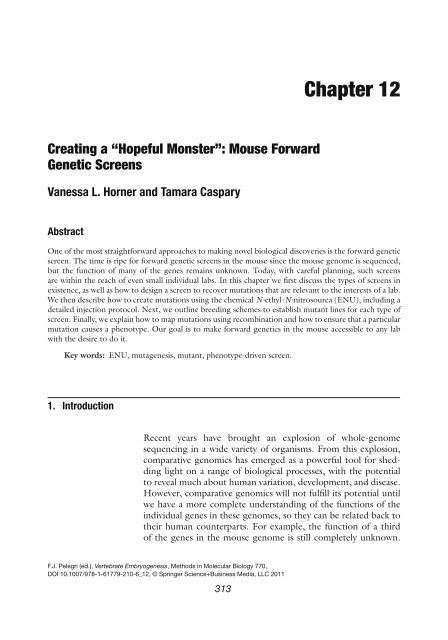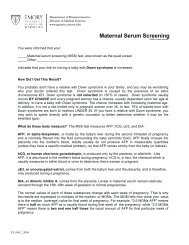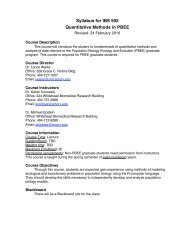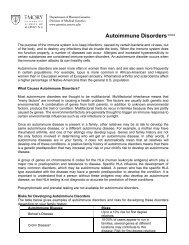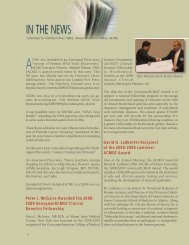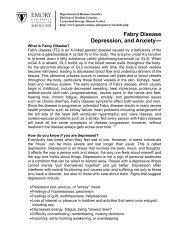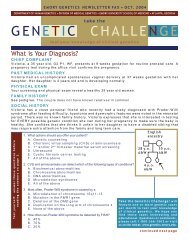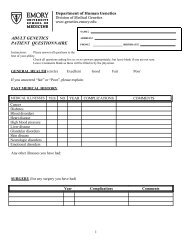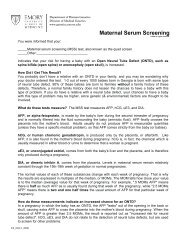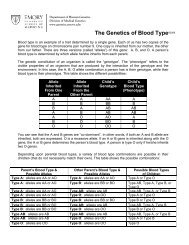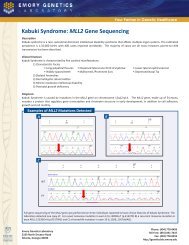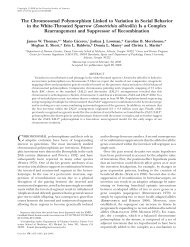770:313-36. Creating a hopeful monster: mouse - Emory University ...
770:313-36. Creating a hopeful monster: mouse - Emory University ...
770:313-36. Creating a hopeful monster: mouse - Emory University ...
You also want an ePaper? Increase the reach of your titles
YUMPU automatically turns print PDFs into web optimized ePapers that Google loves.
<strong>Creating</strong> a “Hopeful Monster”: Mouse Forward<br />
Genetic Screens<br />
Vanessa L. Horner and Tamara Caspary<br />
Abstract<br />
Chapter 12<br />
One of the most straightforward approaches to making novel biological discoveries is the forward genetic<br />
screen. The time is ripe for forward genetic screens in the <strong>mouse</strong> since the <strong>mouse</strong> genome is sequenced,<br />
but the function of many of the genes remains unknown. Today, with careful planning, such screens<br />
are within the reach of even small individual labs. In this chapter we first discuss the types of screens in<br />
existence, as well as how to design a screen to recover mutations that are relevant to the interests of a lab.<br />
We then describe how to create mutations using the chemical N-ethyl-N-nitrosourea (ENU), including a<br />
detailed injection protocol. Next, we outline breeding schemes to establish mutant lines for each type of<br />
screen. Finally, we explain how to map mutations using recombination and how to ensure that a particular<br />
mutation causes a phenotype. Our goal is to make forward genetics in the <strong>mouse</strong> accessible to any lab<br />
with the desire to do it.<br />
Key words: ENU, mutagenesis, mutant, phenotype-driven screen.<br />
1. Introduction<br />
Recent years have brought an explosion of whole-genome<br />
sequencing in a wide variety of organisms. From this explosion,<br />
comparative genomics has emerged as a powerful tool for shedding<br />
light on a range of biological processes, with the potential<br />
to reveal much about human variation, development, and disease.<br />
However, comparative genomics will not fulfill its potential until<br />
we have a more complete understanding of the functions of the<br />
individual genes in these genomes, so they can be related back to<br />
their human counterparts. For example, the function of a third<br />
of the genes in the <strong>mouse</strong> genome is still completely unknown.<br />
F.J. Pelegri (ed.), Vertebrate Embryogenesis, Methods in Molecular Biology <strong>770</strong>,<br />
DOI 10.1007/978-1-61779-210-6_12, © Springer Science+Business Media, LLC 2011<br />
<strong>313</strong>
314 Horner and Caspary<br />
Of the approximately 26,000 genes in the <strong>mouse</strong> genome, 8,154<br />
(31%) genes have no functional annotation (1). Perhaps more<br />
remarkably, 17,904 (68%) genes in the <strong>mouse</strong> genome have no<br />
mutant alleles (1). Several international projects are underway<br />
to produce null alleles of every gene in the <strong>mouse</strong> genome, so<br />
that gene function can be inferred from the resulting phenotype<br />
(2, 3). Such a “reverse genetics” approach will provide valuable<br />
resources to the <strong>mouse</strong> community and fill many gaps in our<br />
knowledge. Complementary to this approach is forward genetics,<br />
which begins with a mutant phenotype in a biological process<br />
of interest and then asks what gene is disrupted to produce that<br />
particular phenotype. Forward genetic screens, therefore, can give<br />
us an unbiased view of a biological process from which novel discoveries<br />
can flow. Furthermore, the nature of the allele obtained<br />
in a mutagenesis screen can tell us a great deal about a particular<br />
protein’s role in a specific process in a way that deletion of<br />
the protein cannot. Finally, another benefit of alleles created via<br />
chemical mutagenesis is that they tend to mimic human disease<br />
alleles (4).<br />
Reverse genetics has become the preferred method for individual<br />
labs studying specific mammalian genes. Recently, however,<br />
a growing number of labs are interested in forward genetics,<br />
largely for two reasons. First, the availability of the <strong>mouse</strong> genome<br />
sequence has made positional cloning much more straightforward,<br />
due in part to a denser set of markers that allows one to<br />
more easily narrow down the region in which a mutation lies. Further,<br />
we now know exactly how many genes are in any particular<br />
region. This information, combined with available gene expression<br />
data, makes it easier to prioritize which genes to sequence to<br />
find the causative mutation. Second, mutagenesis screens in the<br />
<strong>mouse</strong> have the unique ability to impartially reveal a collection<br />
of genes involved in a biological process of interest. In the current<br />
genomics era, where the focus is shifting from understanding<br />
single gene products to understanding how networks of gene<br />
products interact and influence one another, forward genetics is a<br />
particularly apt and powerful tool.<br />
How practical is it for an individual lab to perform a forward<br />
genetic screen in the <strong>mouse</strong>? General concerns are time, breeding<br />
space required, and cost. Although the time from mutagenization<br />
to the establishment of mutant lines is about 1 year, much of<br />
this is passive time spent waiting for males to recover fertility after<br />
mutagenization and setting up crosses. The active screening time<br />
is 4 or 5 months. The amount of breeding space required reflects<br />
this passive/active time pattern, with a long period of housing<br />
relatively few mice, followed by the active screening phase, when<br />
a burst of mice are produced (Fig. 12.1). Once mutant lines<br />
are established, active positional cloning takes several months to<br />
about a year to complete. However, next-generation resequencing<br />
technology holds promise that we will further accelerate this
2. Materials<br />
<strong>Creating</strong> a “Hopeful Monster”: Mouse Forward Genetic Screens 315<br />
Fig. 12.1. Approximate breeding space required per month in a generic yearlong screen<br />
for recessive mutations.<br />
step, as longer portions of a chromosome can be sequenced for<br />
less time and cost. Overall, it is quite feasible for an individual lab<br />
to carry out a mutagenesis screen, and the goal of this chapter is to<br />
provide the reader with practical considerations and instructions<br />
to do just that.<br />
1. Mice: 7- to 8-week-old males of the desired strain for mutagenization<br />
(Section 3.2).<br />
2. N-ethyl-N-nitrosourea (ENU).<br />
3. 95% ethanol: make fresh each time.<br />
4. Phosphate/citrate buffer: 0.1 M dibasic sodium phosphate<br />
and 0.05 M sodium citrate, adjust to pH 5.0 with phosphoric<br />
acid. Make fresh each time.<br />
5. ENU inactivating solution: Use one of the following:<br />
0.1 M potassium hydroxide<br />
Alkaline sodium thiosulfate: 0.1 M sodium hydroxide and<br />
1.3 M sodium thiosulfate.<br />
6. Syringes/needles: For ENU dilution: 18-gauge needles,<br />
10 mL syringes, and 30–50 mL syringes. For ENU injections:<br />
25-gauge needles and 1 mL syringes.<br />
7. Squirt bottles.<br />
8. Waste containers: hazardous waste plastic bags, container<br />
for deactivated ENU, and sharps disposal box.<br />
9. Personal protective equipment for handling ENU: disposable<br />
gowns, masks, gloves.<br />
10. Disposable bench paper to line hood during ENU<br />
injections.
316 Horner and Caspary<br />
3. Methods<br />
3.1. Designing<br />
a Screen<br />
The initial consideration is a critical one: how to design a screen<br />
to recover mutations that suit the interests and goals of the lab?<br />
One way to approach this question is to first determine whether<br />
you are interested in a general biological process or a particular<br />
gene or region of the genome (Fig. 12.2). Those interested in<br />
a general biological process are best served by a genome-wide<br />
screen, since it is likely that numerous genes scattered throughout<br />
the genome control the process of interest. Those more interested<br />
in the functional content of a given region of the genome,<br />
or in generating an allelic series of a particular gene, will find a<br />
region-specific screen more appropriate. Another consideration is<br />
the time it will take to map and clone causative mutations once<br />
the screening is complete. In a genome-wide screen, the recovered<br />
mutations can be at any position on any chromosome. Positional<br />
cloning takes several months to a year to complete, because<br />
one must generate enough embryos to allow up to 1,500 opportunities<br />
for recombination, design primers to find polymorphic<br />
markers, and sequence. Since region-specific screens are limited to<br />
a defined portion of the genome, finding the causative mutation<br />
is greatly simplified, reducing the overall time and cost. We will<br />
examine several classes of both genome-wide and region-specific<br />
genetic screens below.<br />
Having defined screening criteria is another important factor<br />
to consider when designing a screen, for ease of phenotype<br />
identification and reproducibility. For example, our lab recently<br />
completed a screen for recessive mutations that affect embryonic<br />
development. We broadly examined embryos for morphological<br />
abnormalities, but for consistency we chose nine key features to<br />
Fig. 12.2. Classes of genome-wide and region-specific forward genetic screens.<br />
Adapted with permission from Macmillan Publishers Ltd: Nat Rev Genet (33), copyright<br />
2005.
3.1.1. Genome-Wide<br />
Screens<br />
<strong>Creating</strong> a “Hopeful Monster”: Mouse Forward Genetic Screens 317<br />
score, such as brain lobes, eyes, and pharyngeal arches. Increasingly<br />
complex assays can lead to lengthy or slow screening. For<br />
instance, screens that include criteria such as serum analysis or<br />
behavioral assays may limit the number of mutant lines that can<br />
be screened. Each lab must weigh for itself the relative costs and<br />
benefits of including extra steps in a screen.<br />
Genome-wide screens can be designed to recover mutations that<br />
create either dominant or recessive alleles. Dominant alleles cause<br />
a phenotype that is observed in the heterozygous state, either<br />
because two normal alleles are required for normal function of<br />
the gene (haploinsufficiency), because the mutant allele disrupts<br />
the function of the normal allele (dominant negative), or because<br />
the mutant allele has new or increased activity (gain of function).<br />
One purely practical reason to screen for dominant alleles is that<br />
they can be recovered in the fewest number of crosses, thereby<br />
reducing time and cost (Section 3.3). Another possible rationale<br />
for performing a dominant screen is to model a human disease<br />
condition with a dominant mode of transmission (for examples,<br />
see (5)).<br />
Recessive alleles can have partial or total loss of function, and<br />
both alleles must be mutant to produce a phenotype. Therefore,<br />
three crosses are required to recover mutations that create recessive<br />
alleles (Fig. 12.3). The additional breeding time can be justified,<br />
however, since it is easier to infer normal gene function from<br />
recessive alleles, as they are generally loss of function.<br />
The final class of genome-wide screen is the modifier screen:<br />
recovering new genes that suppress or enhance a phenotype of<br />
Fig. 12.3. Crossing scheme for dominant (upper gray box) or recessive (lower gray box)<br />
mutant alleles. In this and all subsequent figures, chromosomes from the mutagenized<br />
black <strong>mouse</strong> are represented as black bars; chromosomes from the white <strong>mouse</strong> are<br />
represented as white bars. Additionally, in all figures stars represent mutant alleles.
318 Horner and Caspary<br />
3.1.2. Region-Specific<br />
Screens<br />
interest. Modifier screens are performed when at least one gene<br />
is known to be necessary for a biological process of interest, and<br />
the goal is to discover other genes in the same pathway or same<br />
process. Modifier screens can be designed to recover dominant or<br />
recessive alleles, as above. They can also be performed with known<br />
alleles that are not viable in the homozygous state, although the<br />
crossing scheme is more involved (Fig. 12.4).<br />
The narrowest type of region-specific screen is the noncomplementation<br />
screen. The purpose of a non-complementation<br />
screen is to find new alleles of a gene of interest, because<br />
mutations in different protein domains can reveal much about<br />
the function of those domains and/or can help to define specific<br />
interactions with other proteins. In a non-complementation<br />
screen, one crosses an animal carrying a known mutation in<br />
a particular allele with an animal carrying random mutations<br />
(Fig. 12.5). If the progeny of such a cross exhibit the mutant<br />
phenotype of the known allele, the newly mutagenized allele is<br />
said to “fail to complement” the original allele. It is important to<br />
note that since mutations are induced randomly in the genome,<br />
a failure to complement can be either allelic or non-allelic; if it is<br />
allelic, then the mutation will be revealed through sequencing the<br />
gene in the new mutant background. If it is non-allelic, the mutation<br />
must be mapped via meiotic recombination (Section 3.4).<br />
Deletion screens incorporate <strong>mouse</strong> strains with deletions in<br />
known portions of their genome. A number of deletion strains are<br />
available in the <strong>mouse</strong>, with about half of the chromosomes having<br />
at least one “deletion complex” or collection of overlapping<br />
deletions (Table 12.1). The first seven deletion complexes were<br />
Fig. 12.4. Crossing scheme for dominant (upper gray box) or recessive (lower gray box)<br />
modifier alleles. In this crossing scheme the allele to be modified (in the white <strong>mouse</strong>)<br />
is assumed to be homozygous lethal or sterile. The half-black/half-white chromosome<br />
in the second generation indicates that either allele is acceptable in this cross.
<strong>Creating</strong> a “Hopeful Monster”: Mouse Forward Genetic Screens 319<br />
Fig. 12.5. Non-complementation crossing scheme. (a) The allele to be tested (in white<br />
<strong>mouse</strong>) is viable and fertile as a homozygote. (b) The allele to be tested (in white <strong>mouse</strong>)<br />
is lethal or sterile as a homozygote.<br />
generated by irradiating or chemically mutating mice and then<br />
crossing them to mice with visible markers. In this way deletions<br />
could be located to the region surrounding the visible marker<br />
(specific locus test; (6)). These initial deletion complexes each<br />
contain many available <strong>mouse</strong> strains with overlapping deletions<br />
(Table 12.1, gray rows). More recently, deletion complexes are<br />
created in genomic areas of interest using embryonic stem cells<br />
(ES cells). Deletions are generated in ES cells through irradiation<br />
or through Cre–loxP-mediated recombination and then mice<br />
bearing the deletions are produced from the ES cells, when possible<br />
(Table 12.1, white rows) (7–10). In addition to simplifying<br />
the mapping process, another practical reason to perform a deletion<br />
screen is that recessive mutations can be recovered in fewer<br />
crosses than in a genome-wide recessive screen (Fig. 12.6). The<br />
only caveat is that the deletion strain used in the screen must be<br />
viable as a heterozygote (i.e., cannot be haploinsufficient), a fact<br />
not yet known for the deletions that only exist as ES cells.<br />
The final region-specific screen is the balancer screen, modeled<br />
after successful screens performed in Drosophila melanogaster<br />
and Caenorhabditis elegans. A “balancer chromosome” is one that<br />
contains inversions to prevent recombination with its homolog,<br />
plus a dominant marker, so that animals carrying it can be recognized.<br />
Balancer chromosomes may contain recessive lethal mutations<br />
as well. They are called “balancers” because they prevent<br />
any lethal or sterile mutations on the homologous chromosome<br />
from being removed from a population (i.e., they maintain
320 Horner and Caspary<br />
Table 12.1<br />
Mouse chromosomal deletion complexes<br />
Chr<br />
Deletion<br />
Complex<br />
2 Non-agouti<br />
(a)<br />
No.<br />
<strong>mouse</strong>/cell<br />
lines Mode of generation<br />
∼17 <strong>mouse</strong><br />
lines<br />
Mixed (chemical<br />
and radiation) of<br />
<strong>mouse</strong>/germ cells<br />
2 Notch1 10 cell lines ES cell:<br />
recombinationmediated<br />
deletion<br />
4 Brown<br />
(Tyrp1 b )<br />
5 Hdh, Dpp6,<br />
Gabrb1<br />
∼35 <strong>mouse</strong><br />
lines<br />
10 <strong>mouse</strong><br />
lines<br />
7 Albino (Tyr c ) ∼55 <strong>mouse</strong><br />
lines<br />
7 Pink-eyed<br />
dilution (p)<br />
9 Dilute<br />
(Myo5a d )<br />
9 Short ear<br />
(Bmp5 se )<br />
9 Dilute and<br />
Short ear<br />
(d se)<br />
∼65 <strong>mouse</strong><br />
lines<br />
∼16 <strong>mouse</strong><br />
lines<br />
∼4 <strong>mouse</strong><br />
lines<br />
∼29 <strong>mouse</strong><br />
lines<br />
Mixed (chemical<br />
and radiation) of<br />
<strong>mouse</strong>/germ cells<br />
ES cell: X-ray<br />
irradiation<br />
Mixed (chemical<br />
and radiation) of<br />
<strong>mouse</strong>/germ cells<br />
Mixed (chemical<br />
and radiation) of<br />
whole <strong>mouse</strong><br />
Mixed (chemical<br />
and radiation) of<br />
<strong>mouse</strong>/germ cells<br />
Mixed (chemical<br />
and radiation) of<br />
<strong>mouse</strong>/germ cells<br />
Mixed (chemical<br />
and radiation) of<br />
<strong>mouse</strong>/germ cells<br />
9 Ncam 28 cell lines ES cell: X and UV<br />
irradiation<br />
11 Hsd17b1 [Del<br />
(11) Brd]<br />
14 Piebald<br />
(Ednrb s )<br />
8 <strong>mouse</strong> lines ES cell:<br />
recombinationmediated<br />
deletion<br />
20 <strong>mouse</strong><br />
lines<br />
Mixed (chemical<br />
and radiation) of<br />
<strong>mouse</strong>/germ cells<br />
15 Sox10 2 <strong>mouse</strong> lines ES cell: X-ray<br />
irradiation<br />
15 Oc90 2 <strong>mouse</strong> lines ES cell: X-ray<br />
irradiation<br />
15 Cpt1b 192 cell lines ES cell: X-ray<br />
irradiation<br />
Total span of<br />
nested<br />
deletions,<br />
if known Reference<br />
6.2–7.7 cM<br />
(10.4 Mb)<br />
(1, 6, 34, 35)<br />
(36)<br />
∼21 Mb (1, 6, 37–39)<br />
40 cM (40)<br />
6–11 cM for<br />
29 of the<br />
lines<br />
28 cM (8)<br />
8Mb (49)<br />
(1, 6, 41, 42)<br />
(1, 6, 43–45)<br />
(1, 6, 46, 47)<br />
(1, 6, 47, 48)<br />
(1, 6, 47)<br />
15.7–18 cM (1, 6, 50, 51)<br />
577 kb (52)<br />
658 kb-5 Mb (52)<br />
(52)
Table 12.1<br />
(continued)<br />
Chr<br />
Deletion<br />
Complex<br />
17 D17Aus9 3–7 <strong>mouse</strong><br />
lines<br />
17 Sod2,<br />
D17Leh94<br />
<strong>Creating</strong> a “Hopeful Monster”: Mouse Forward Genetic Screens 321<br />
No.<br />
<strong>mouse</strong>/cell<br />
lines Mode of generation<br />
ES cell:<br />
X-ray irradiation<br />
8 <strong>mouse</strong> lines ES cell: X-ray<br />
irradiation<br />
X Hprt 4 cell lines ES cell:<br />
recombinationmediated<br />
deletion<br />
X Hprt 9 cell lines ES cell: X and UV<br />
irradiation<br />
X Hprt 2 <strong>mouse</strong> lines ES cell: X-ray<br />
irradiation<br />
Total span of<br />
nested<br />
deletions, if<br />
known Reference<br />
322 Horner and Caspary<br />
Fig. 12.7. Balancer screen crossing scheme. The white bar with double-sided arrows<br />
indicates the balanced chromosome. In the first generation, F1 mice are crossed to<br />
mice carrying the inversion in trans to a WT chromosome marked with a dominant<br />
visible mutation (dotted bar with black circle). Mutant alleles are recovered in the third<br />
generation (gray box).<br />
rently there are not yet many balancer <strong>mouse</strong> strains available (see<br />
Table 12.2). However, they can be generated using recombination<br />
in ES cells (7, 11, 12). Furthermore, more G0 males may<br />
need to be injected, because only half of the F1 males will be<br />
subsequently used (those carrying the balancer, see Fig. 12.7).<br />
Finally, when screening for embryonic lethal phenotypes, it is best<br />
to use a balancer that is viable when homozygous to prevent confusion<br />
about the cause of lethality.<br />
3.2. Mutagenization There are several methods to mutagenize the <strong>mouse</strong> genome:<br />
chemicals like N-ethyl-N-nitrosourea (ENU) and chlorambucil,<br />
irradiation with X-rays or gamma rays, and transposons such<br />
as sleeping beauty (6, 13–17). For the purposes of this chapter<br />
we focus on the most widely used method, the chemical<br />
ENU. ENU is a powerful mutagen. Depending on the strain of<br />
<strong>mouse</strong> and the dose given, ENU induces a point mutation every<br />
0.5–16 Mb throughout the genome (18–22), which is about 100<br />
times higher than the spontaneous mutation rate per generation<br />
in humans (23). Further, ENU primarily affects spermatogonial<br />
stem cells, so that one male <strong>mouse</strong> will produce multiple clones<br />
of mutated sperm after completion of spermatogenesis (24). In<br />
addition to its efficient nature, another advantage of ENU is the<br />
variety of protein altercations that can result from this form of<br />
mutagenization. Since ENU is an alkylating agent that induces<br />
point mutations, nonsense (10%), missense (63%), splicing (26%),<br />
and “make-sense” (1%) mutations can all occur (reviewed in<br />
(25–27)). Therefore, in addition to null alleles, other alleles<br />
will also be generated, including hypomorphs, hypermorphs, and
<strong>Creating</strong> a “Hopeful Monster”: Mouse Forward Genetic Screens 323<br />
Table 12.2<br />
Mouse balancer strains (strains that are viable as homozygotes are indicated)<br />
Chr Name<br />
4 Inv<br />
(4)Brd1 Mit281-Mit51<br />
4 Inv<br />
(4)Brd1 Mit117-Mit281<br />
Dominant<br />
marker<br />
phenotype<br />
(gene)<br />
Coat color<br />
(Tyrosinase and<br />
K14-agouti)<br />
Coat color<br />
(Tyrosinase and<br />
K14-agouti)<br />
5 Rump white (Rw) Coat color (Kit<br />
receptor tyrosine<br />
kinase)<br />
10 Steel panda (Sl pan ) Coat color (Kit<br />
ligand)<br />
11 Inv (11) Trp53-Wnt3 Coat color<br />
(K14-agouti)<br />
11 Inv (11) Wnt3-D11Mit69 Coat color<br />
(K14-agouti)<br />
11 Inv (11) Trp53-EgfR Coat color<br />
(K14-agouti)<br />
15 In (15)2R1 Short, hairy ears<br />
(Eh)<br />
15 In (15)21Rk Coat color<br />
(K14-agouti)<br />
3.2.1. Inbred Strains and<br />
ENU Dose<br />
Recessive<br />
lethal?<br />
(gene, if<br />
known)<br />
Mode of<br />
generation Reference<br />
No Cre–loxPmediated<br />
recombination<br />
No Cre–loxPmediated<br />
recombination<br />
(55)<br />
(55)<br />
Yes Irradiation (56, 57)<br />
No Irradiation (58)<br />
Yes (Wnt3) Cre–loxPmediated<br />
recombination<br />
Yes (Wnt3) Cre–loxPmediated<br />
recombination<br />
No Cre–loxPmediated<br />
recombination<br />
Yes Chemical<br />
mutagenesis or<br />
irradiation<br />
Yes Modification of<br />
line derived<br />
from chemical<br />
mutagenesis or<br />
irradiation<br />
(12)<br />
(59)<br />
(59)<br />
(60)<br />
(61)<br />
dominant-negative alleles. This ability to generate an allelic series<br />
is one of the great strengths of forward genetics.<br />
One of the first practical considerations is which strain of mice to<br />
mutagenize. A popular choice is C57BL/6J, because the effective<br />
dose of ENU is well defined and the genome is sequenced for<br />
this strain, facilitating future mapping and analysis portions of the<br />
screen. Nevertheless, with the increased density of genetic markers<br />
and cheaper and more advanced resequencing technologies,<br />
choosing other strains has become feasible. Such advancements<br />
allow more flexibility in screen design, for instance by enabling
324 Horner and Caspary<br />
3.2.2. Number of Mice<br />
to Inject<br />
Table 12.3<br />
Recommended dose of ENU for different inbred <strong>mouse</strong> strains<br />
Inbred<br />
<strong>mouse</strong> strain<br />
Recommended<br />
dose (mg/kg) a<br />
No. days of<br />
sterility<br />
Percent<br />
regained<br />
fertility<br />
A/J 3 × 90 74–113 90 (n = 10)<br />
BALB/cJ 3 × 100 89–154 83 (n = 6)<br />
BTBR/N 1 × 150–200 70–210 50–83 (ND)<br />
C3He/J 3 × 85 96–148 70 (n = 10)<br />
C3HeB/FeJ 3 × 75 89–142 90 (n = 10)<br />
C57BL/6J 3 × 100 90–105 80 (n = 10)<br />
a The doses are recommended based on the least amount of death and shortest period<br />
of sterility. For details and alternate doses, see the original papers.<br />
ND = no data.<br />
Modified from (28, 29).<br />
one to incorporate visible markers (such as GFP) that may only<br />
be available on a particular genetic background. When choosing<br />
the strain of mice to mutagenize, it is important to note that<br />
ENU affects inbred strains differently (Table 12.3). In all strains,<br />
ENU initially depletes all spermatogonia from the testes, leading<br />
to a period of sterility from which some males never recover.<br />
In addition, some mice may die during the sterile period due to<br />
somatic mutations that lead to cancer or increase susceptibility<br />
to pathogens. The length of the sterile period and the deaths<br />
vary with ENU dosage and each inbred strain; some strains (like<br />
BALB/cJ and C57BL/6J) can tolerate a relatively high dose,<br />
whereas others (like FVB/N) are very sensitive to ENU. For successful<br />
mutagenesis, one must balance the highest possible mutation<br />
load with the lowest rates of sterility and death. Thanks to<br />
careful analysis and experimentation by Justice et al. (28) and<br />
Weber et al. (29), the optimal ENU dose for various inbred strains<br />
can be estimated; we provide a summary in Table 12.3. Asindicated<br />
in Table 12.3, a fractionated series of injections at weekly<br />
intervals is generally more effective than one single large injection,<br />
since a series maximizes the mutagenic effect and minimizes<br />
animal lethality (30). For instance, rather than a single dose of<br />
300 mg/kg, inject 3 doses of 100 mg/kg at weekly intervals<br />
(written as 3 × 100 mg/kg).<br />
The number of males to inject depends on how many genes in<br />
the genome one wishes to survey. Each F1 animal is estimated<br />
to be heterozygous for about 20–30 gene-inactivating mutations,<br />
based on the specific locus test and data from other mutagenesis<br />
screens (6, 31). In a genome-wide screen, 100 F1 lines will
3.2.3. ENU Injection<br />
Protocol<br />
3.2.3.1. Prior to Injection<br />
3.2.3.2. Day of Injection<br />
<strong>Creating</strong> a “Hopeful Monster”: Mouse Forward Genetic Screens 325<br />
therefore interrogate 2,000–3,000 genes, about 8–12% of the<br />
genome. Since ENU mutagenizes spermatogonial stem cells leading<br />
to clones of mutant sperm, not more than eight F1 animals<br />
should come from any particular G0 father, to avoid rescreening<br />
the same mutation. In theory, for 100 F1 lines, a minimum of<br />
12–13 G0 males should be injected. However, since some percentage<br />
of the G0 males will either fail to recover fertility or die<br />
(or both), it is good practice to inject about three times the minimum<br />
number of males. For example, in a recently completed<br />
genetic screen in our lab, we injected 50 C57/BL6 males with 3<br />
× 100 mg/kg ENU. After 10–12 weeks, about half the males had<br />
died before recovering fertility. From the remaining G0 males, we<br />
recovered 122 F1 males.<br />
ENU is carcinogenic and must be handled with extreme care<br />
(modified from (32)). Most institutions require an IACUC safety<br />
approval justification and common FAQs on ENU. ENU can be<br />
obtained as 1 g of powder in a light-protected ISOPAC container.<br />
ENU is sensitive to light, humidity, and pH. For this reason, it<br />
should be stored at –20 ◦ C in the dark until use and then diluted<br />
not more than 3 h before injection.<br />
1. Complete all institutional IACUC safety approval procedures<br />
(varies from institution to institution).<br />
2. Order male mice of the strain to be injected so that they will<br />
be 7–8 weeks old at the time of injection, keeping in mind<br />
that they will need at least 1 week to adjust to their new<br />
environment after arrival.<br />
3. Make all solutions and gather all materials (see above).<br />
4. Weigh all males to be injected and calculate the amount of<br />
ENU to inject per <strong>mouse</strong>, based on the following formula:<br />
10 mg/mL ENU (x mL to inject)<br />
= (final concentration of ENU)(<strong>mouse</strong> body weight)<br />
For example, if you want a final concentration of 100 mg/kg<br />
ENU in a 20 g C57BL/6J <strong>mouse</strong>:<br />
10 mg/mL ENU (x mL to inject) = (0.1 mg/g)(20 g)<br />
x = 0.2 mL of 10 mg/mL ENU, for a final concentration of<br />
100 mg/kg ENU<br />
5. Dissolve and dilute ENU to 10 mg/mL (see Note 1):<br />
a. Inject 10 mL of 95% ethanol into the ISPOAC container.<br />
Swirl gently to dissolve. When dissolved, ENU is a clear<br />
yellow liquid.
326 Horner and Caspary<br />
3.2.3.3. After Injection<br />
3.3. Breeding<br />
Crosses and<br />
Establishment<br />
of Mutant Lines<br />
3.3.1. Genome-Wide<br />
Screen: Dominant<br />
Mutations<br />
b. Vent ISOPAC with an 18-gauge needle. Inject 90 mL of<br />
phosphate/citrate buffer into container.<br />
6. Inject mice: an experienced person familiar with intraperitoneal<br />
injections should inject each <strong>mouse</strong> with the proper<br />
volume (determined from the formula above) following<br />
standard procedures.<br />
7. After injection, the mice will become uncoordinated from<br />
the alcohol and lose consciousness for a short time, usually<br />
about 20 min. During this time they should be monitored<br />
to ensure they recover consciousness.<br />
8. Deactivate and dispose of ENU: ENU should be completely<br />
deactivated. Since it has a short half-life under alkaline conditions,<br />
use one of the two inactivating solutions given above<br />
to thoroughly rinse all materials that came in contact with<br />
ENU. In our experience it is best to minimize handling<br />
the materials on the day of injection; therefore, we leave all<br />
materials in the hood with the light on overnight to further<br />
ensure that the ENU is deactivated. Prominent signs should<br />
be displayed on the hood and room in which ENU is deactivating,<br />
alerting unknowing staff and coworkers to the presence<br />
of ENU.<br />
9. After the last weekly injection, let males recover for 2–3<br />
weeks.<br />
10. A good indication that the mutagenesis was successful is<br />
sterile males. To ensure that males are sterile, mate them<br />
with females (at this time the females can be any strain<br />
and can likely be used for other experiments if the males<br />
are indeed sterile). Males are sterile if mating plugs are<br />
observed but the females do not become pregnant.<br />
11. Starting 2–3 weeks before the males are expected to regain<br />
fertility (see Table 12.3), set males up with 1 or 2 females<br />
of the desired strain (usually different from the G0 strain,<br />
for mapping purposes, see below).<br />
Once the G0 males have recovered fertility, the more active phase<br />
of the screening process begins: breeding crosses to screen for<br />
mutant phenotypes and establish mutant lines. The class of screen<br />
dictates the series of crosses to perform; each crossing scheme is<br />
outlined below.<br />
1. 1st cross: Cross the mutagenized G0 male to one or two<br />
females of a different (preferably inbred) strain. It is advantageous<br />
to cross the G0 males to females of a different<br />
strain, as polymorphic markers between the strains permit
<strong>Creating</strong> a “Hopeful Monster”: Mouse Forward Genetic Screens 327<br />
Table 12.4<br />
The number of informative SNPs between common inbred strains. The polymorphic<br />
SNPs are derived from a low-density whole-genome SNP panel of 768 SNPs<br />
C57BL/<br />
6J<br />
129X1/<br />
SvJ<br />
BALB/<br />
cJ<br />
C3H/<br />
HeJ<br />
DBA/2J FVB/NJ A/J CBA/J C57BL/<br />
10J<br />
C57BL/6J 508 497 598 555 539 581 562 68<br />
129X1/SvJ 315 333 365 316 367 <strong>313</strong> 455<br />
BALB/cJ 233 323 285 203 262 448<br />
C3H/HeJ 241 294 226 111 552<br />
DBA/2J 323 325 235 518<br />
FVB/NJ 274 281 492<br />
A/J 276 547<br />
CBA/J 514<br />
From the Mutation Mapping and Developmental Analysis Project (MMDAP), with permission from J. L. Moran and<br />
D. R. Beier (personal communication).<br />
3.3.2. Genome-Wide<br />
Screen: Recessive<br />
Mutations<br />
straightforward mutation mapping (Section 3.4). The number<br />
of polymorphisms between strains varies, so this should<br />
be taken into account when choosing the crossing strain<br />
(Table 12.4).<br />
2. Dominant mutations will be recovered in the first generation<br />
(F1) (upper gray box in Fig. 12.3). Since the mutations<br />
occur randomly in the sperm of the G0 male, each F1 animal<br />
represents a unique suite of mutations and is thus considered<br />
a “line.” However, since the G0 spermatogonial stem cells<br />
are mutated, it is best to screen not more than eight F1 animals<br />
from any one G0 male to avoid rescreening the same<br />
mutation. Collect F1 animals and screen for the phenotype<br />
of interest. Once F1 animals with an interesting phenotype<br />
are identified, they must be maintained as separate lines. If<br />
the dominant mutation is viable and fertile, it is simply a<br />
matter of breeding the F1 animal to the same inbred strain<br />
chosen in cross #1.<br />
1. 1st cross: Same as above. Collect eight F1 males per G0 male<br />
and allow them to come to breeding age. Discard F1 females<br />
(Fig. 12.3).
328 Horner and Caspary<br />
3.3.3. Genome-Wide<br />
Screen: Dominant or<br />
Recessive Modifier<br />
3.3.4. Region-Specific<br />
Screen:<br />
Non-complementation,<br />
if the Starting Allele Is<br />
Homozygous Viable and<br />
Fertile<br />
2. 2nd cross: Breed each F1 male individually to two wild-type<br />
females of the same inbred strain used in the 1st cross.<br />
Collect G2 females only and allow them to come to breeding<br />
age; discard G2 males to save <strong>mouse</strong> room space and cost<br />
(new G2 males can be obtained later, if needed, to establish<br />
lines of interest).<br />
3. 3rd cross: Backcross G2 females to their F1 fathers. Mate at<br />
least six G2 females to each F1 male. When a phenotype has<br />
been observed in at least two G3 animals from two separate<br />
G2 females, it is likely genetic (see Note 2). To maintain<br />
the line, collect G2 males and mate them to their sibling G2<br />
females to determine whether the G2 male is a carrier; carrier<br />
males are then kept for subsequent breeding and analysis<br />
(Section 3.4).<br />
Alternative 3rd cross: A theoretical drawback to backcrossing the<br />
G2 females to F1 males is that it places reproductive strain on<br />
the F1 male, since he will be needed to produce many litters.<br />
In our experience, however, we have not encountered problems<br />
with this. Nonetheless, an alternative to backcrossing is intercrossing<br />
G2 male and female siblings. This method has the advantage<br />
that G2 carrier males are immediately identified; a drawback is<br />
that both G2 males and females must be weaned from the second<br />
cross, above, increasing <strong>mouse</strong> room space and cost.<br />
The breeding scheme presented here assumes that the mutation<br />
to be modified is not viable in the homozygous state (white<br />
<strong>mouse</strong> in Fig. 12.4).<br />
1. 1st cross: Cross G0 males to females of a different strain who<br />
are heterozygous for the allele to be modified. Collect F1<br />
animals (not more than eight per G0 male, as above) and<br />
allow them to come to breeding age.<br />
2. 2nd cross: Cross F1 animals to animals of the same strain as<br />
the females crossed to G0 males, above. Dominant modifiers<br />
will be seen in G2 animals; collect and screen for enhancement<br />
or suppression of the phenotype of interest.<br />
3. 3rd cross: Backcross G2 females to their F1 fathers. Recessive<br />
modifiers will be seen in G3 animals; collect and screen for<br />
enhancement or suppression of the phenotype of interest.<br />
1. 1st cross: Cross G0 males with females of a different inbred<br />
strain who are homozygous for the allele of interest. Collect<br />
F1 animals (not more than eight per G0 male, as<br />
above) and screen them for failure to complement the mutation<br />
(Fig. 12.5) (i.e., exhibit the same phenotype as animals<br />
homozygous for the starting allele (white <strong>mouse</strong> in<br />
Fig. 12.5a)).
3.3.5. Region-Specific<br />
Screen:<br />
Non-complementation, if<br />
the Starting Allele Is<br />
Homozygous Lethal or<br />
Sterile<br />
3.3.6. Region-Specific<br />
Screen: Deletion Screen<br />
for Lethal or Sterile<br />
Recessive Mutations<br />
3.3.7. Region-Specific<br />
Screen: Using Balancers<br />
3.4. Analysis and<br />
Cloning<br />
<strong>Creating</strong> a “Hopeful Monster”: Mouse Forward Genetic Screens 329<br />
1. 1st cross: Cross G0 males with wild-type females of the same<br />
genetic background as those containing the allele of interest.<br />
Collect F1 animals (not more than eight per G0 male, as<br />
above) and allow them to come to breeding age.<br />
2. 2nd cross: Cross F1 animals to animals that are heterozygous<br />
for the allele of interest. Screen the resulting G2 progeny for<br />
a failure to complement the allele of interest. As mentioned<br />
above, a failure to complement (Fig. 12.5) can be either<br />
allelic or non-allelic, and this can be determined through<br />
direct sequencing of the gene in the new mutant background<br />
(White Mouse in Fig. 12.5b).<br />
1. 1st cross: Cross G0 males to wild-type females from the same<br />
genetic background as the deletion strain used in the 2nd<br />
cross, below. Collect F1 animals and allow them to come to<br />
breeding age (Fig. 12.6).<br />
2. 2nd cross: Cross F1 animals to animals hemizygous for a<br />
deleted region of interest. Any recessive mutations that<br />
occur in trans to the deleted region will be observable in<br />
the G2 progeny.<br />
1. 1st cross: Cross G0 males to females of a different inbred<br />
strain who are heterozygous for a balancer chromosome.<br />
Collect F1 animals carrying the balancer chromosome (onehalf<br />
of the F1 progeny) and allow them to come to breeding<br />
age (Fig. 12.7).<br />
2. 2nd cross: Cross F1 animals carrying the balancer to animals<br />
carrying the balancer in trans to a wild-type chromosome<br />
marked with a dominant visible marker that is distinct<br />
from the visible marker on the balancer chromosome. Collect<br />
G2 animals that are heterozygous for the newly mutated<br />
chromosome over the balancer chromosome (can be distinguished<br />
based on visible markers). Discard the rest of the<br />
progeny.<br />
3. 3rd cross: Backcross G2 animals to their F1 parents. The G3<br />
animals can again be distinguished by their visible markers. If<br />
a G3 animal is not carrying a balancer chromosome, then it<br />
is homozygous for the newly mutated chromosome. If such<br />
animals exhibit a phenotype, then the mutation lies in the<br />
balanced region of the genome. However, if a G3 animal<br />
has a phenotype but is heterozygous for the balancer, then<br />
the mutation lies outside the balanced region, elsewhere in<br />
the genome.<br />
The excitement of establishing a new mutant line with an interesting<br />
phenotype may only be surpassed by discovering the
330 Horner and Caspary<br />
3.4.1. Mapping Based<br />
on Recombination<br />
underlying genetic change that causes the phenotype. Traditionally,<br />
there are three main steps to accomplish this goal: recombination<br />
mapping to narrow down the genomic interval in which a<br />
mutation lies, sequencing candidate genes in this genomic interval,<br />
and confirming that a particular mutation is indeed responsible<br />
for the observed phenotype.<br />
Since mice from one inbred strain (x) are mutagenized and then<br />
crossed to mice of another inbred strain (y), the F1 generation<br />
is 50% x and 50% y. In the process of establishing and maintaining<br />
mutant lines, mice are continually crossed to the nonmutagenized<br />
(y) background, all the while selecting for the mutation.<br />
Over several generations, therefore, the genome of the<br />
mutant lines will largely be of the y background, while the region<br />
surrounding the mutation will be of the x background. The<br />
premise of recombination mapping is that the causative mutation<br />
will be linked to the x background, which can be distinguished<br />
by polymorphisms that differ between the x and y backgrounds.<br />
There are two main classes of polymorphisms used in<br />
recombination mapping: simple sequence length polymorphisms<br />
(SSLPs), which are short repeated segments that differ in length<br />
between inbred strains, and single nucleotide polymorphisms<br />
(SNPs). Both classes can be used to create polymorphic “markers.”<br />
SSLP markers are created by designing PCR primers around<br />
the SSLP, so that the size of the PCR product differs between<br />
two strains. SNP markers can be created by finding SNPs that<br />
create restriction fragment length polymorphisms (RFLPs), also<br />
detectable by PCR. In addition, SNPs can be genotyped directly<br />
using array-based SNP panels (see below).<br />
The first step of recombination mapping is to determine on<br />
which chromosome the mutation lies. This is achieved by performing<br />
a genome-wide scan using polymorphic markers that are<br />
spaced at regular intervals throughout the genome at low density.<br />
Several commercially available SNP panels have been designed<br />
for this purpose. For example, Illumina’s <strong>mouse</strong> Low Density<br />
(LD) and Medium Density (MD) Linkage Panels contain 377 and<br />
1,449 SNPs, respectively, spaced across the entire <strong>mouse</strong> genome.<br />
DNA from affected (mutant) animals is obtained, and the SNPs<br />
contained in the linkage panels are genotyped to determine which<br />
chromosome has the largest cluster of DNA from the mutagenized<br />
background. The required starting amount of DNA is low<br />
(750 ng–1.5 μg) and can be obtained from tissue from a single<br />
animal. To detect linkage, DNA from eight or nine affected animals<br />
should be SNP genotyped.<br />
The next step is high-resolution mapping, which is essentially<br />
the same process, but using markers that are more closely spaced.<br />
In the course of mapping their own mutations, several groups<br />
have created polymorphic markers and made them available to
<strong>Creating</strong> a “Hopeful Monster”: Mouse Forward Genetic Screens 331<br />
the public (see online resources, below). You should first determine<br />
whether any of the available markers are appropriate for your<br />
use. If there are no informative markers in the region of interest,<br />
then markers will need to be created. Step-by-step instructions<br />
are available from the Sloan-Kettering site, below. Use the markers<br />
to genotype both affected and non-affected animals from each<br />
line. Since affected animals are known to carry the mutation, and<br />
the mutation lies in a region of mutagenized background DNA<br />
(e.g., “x”), informative animals will be recombinants that have<br />
wild-type DNA (e.g., y) adjacent to mutagenized DNA. Since the<br />
portion of the chromosome containing wild-type DNA cannot<br />
contain the mutation, that portion can be ruled out. As more<br />
affected recombinant animals are genotyped, longer portions of<br />
the chromosome are eliminated. Conversely, non-affected recombinant<br />
animals are used to rule out portions of the chromosome<br />
that are homozygous for mutagenized DNA (for recessive alleles).<br />
It is important to note that, if there are any issues with penetrance<br />
of the phenotype one can easily be misled by apparently<br />
non-affected animals and may want to exclude them from analysis.<br />
Below is a partial list of online resources to locate or design<br />
appropriate markers:<br />
Sloan-Kettering Mouse Project Website: https://<strong>mouse</strong>.mskcc.<br />
org<br />
1. MarkerBase: Provides a list of available Sloan-Kettering<br />
Institute (SKI) developed makers, a searchable database<br />
of Massachusetts Institute of Technology (MIT) markers,<br />
and a guide to create your own.<br />
Mouse Genome Informatics (MGI): www.informatics.jax.org<br />
1. Integrated Whitehead/MIT Linkage and Physical maps:<br />
Provides a list of available MIT markers by chromosome:<br />
www.informatics.jax.org/reports/mitmap<br />
2. Strains, SNPs, and polymorphisms<br />
a.SNP query: search for SNPs by strain, SNP attributes,<br />
genomic position, or associated genes.<br />
b.Search for RFLP- or PCR-based polymorphisms by<br />
strain, locus symbol, or map position.<br />
Ensembl Genome Browser: www.ensembl.org/Mus_<br />
musculus/Info/Index<br />
1. Browse for SNPs by chromosome (karyotype) or enter<br />
genomic location.<br />
a. Genetic variation: resequencing data for nine inbred<br />
strains are compared with the C57BL/6J genomic<br />
sequence, and SNPs are highlighted.<br />
3.4.2. Sequencing Once the genomic interval in which a mutation lies has been narrowed<br />
sufficiently, the next step is to sequence candidate gene(s)<br />
in the interval. A number of factors influence the decision of when
332 Horner and Caspary<br />
and what to begin sequencing. One consideration is whether<br />
there are additional polymorphisms that could potentially narrow<br />
the interval further. However, the chance of obtaining recombinant<br />
animals decreases as the interval is narrowed. Perhaps the<br />
best indicator that the time to sequence has come is that there are<br />
a manageable number of genes in the interval, which may or may<br />
not be correlated with the physical size of the interval. What is<br />
“manageable” depends on the investigator, but larger collections<br />
of genes can be prioritized for sequencing based on expression<br />
data or any available phenotypic data. In addition, since ENU<br />
causes mutations in exons and splice sites in the vast majority of<br />
cases, sequencing entire genes is not necessary.<br />
The availability of next-generation resequencing technologies<br />
is poised to change how investigators perceive what is a manageable<br />
number of genes to sequence. It is becoming practical to<br />
sequence very long portions of a chromosome at a time and for<br />
less money. This technology may drastically alter the balance of<br />
time spent mapping versus sequencing, to the point that, ultimately,<br />
one may only need to know which chromosome contains<br />
the mutation before beginning to sequence.<br />
3.4.3. Confirmation How do you know that a mutation actually causes the observed<br />
phenotype? Direct evidence includes genetic rescue or complementation.<br />
Genetic rescue occurs when a wild-type copy of the<br />
gene is introduced into the mutant background, and the mutant<br />
phenotype is no longer observed. Although direct, this method<br />
is time consuming because it involves creating transgenic mice.<br />
The other direct method is a complementation analysis, which<br />
involves creating mice that have one copy of your mutant allele<br />
and one copy of a known mutant allele in the suspected gene. If<br />
the mutant phenotype is seen in such an animal, then your allele<br />
fails to complement the phenotype and is an allele of the suspected<br />
gene. While this is faster than genetic rescue, it depends<br />
on the availability of mutant alleles in the gene of interest. There<br />
can also be indirect evidence that a mutation causes the observed<br />
phenotype, including disruption of gene expression, protein production,<br />
protein activity, or cellular/tissue localization. Other<br />
indirect evidence may be that the observed mutant phenotype<br />
is similar to other alleles of the suspected gene or is similar to the<br />
mutant phenotype of genes in the same pathway.<br />
4. Notes<br />
1. ENU: To spec or not to spec? The concentration of ENU<br />
can be determined by spectrophotometry after dilution<br />
in phosphate/citrate buffer. This is the best way to be
References<br />
1. Bult, C. J., Eppig, J. T., Kadin, J. A., Richardson,<br />
J. E., and Blake, J. A. (2008) The Mouse<br />
Genome Database (MGD): <strong>mouse</strong> biology<br />
and model systems. Nucleic Acids Res. 36,<br />
D724–728.<br />
2. Collins, F. S., Finnell, R. H., Rossant, J., and<br />
Wurst, W. (2007) A new partner for the international<br />
knockout <strong>mouse</strong> consortium. Cell<br />
129, 235.<br />
3. Collins, F. S., Rossant, J., Wurst, W., and<br />
Consortium, T. I. M. K. (2007) A <strong>mouse</strong> for<br />
all reasons. Cell 128, 9–13.<br />
4. O‘Brien, T. P. and Frankel, W. N. (2004)<br />
Moving forward with chemical mutagenesis<br />
in the <strong>mouse</strong>. J. Physiol. 554, 13–21.<br />
5. Hamosh, A., Scott, A. F., Amberger, J.<br />
S., Bocchini, C. A., and McKusick, V. A.<br />
(2005) Online Mendelian Inheritance in<br />
Man (OMIM), a knowledgebase of human<br />
genes and genetic disorders. Nucleic Acids<br />
Res. 33, D514–517.<br />
6. Russell, W. L., Kelly, E. M., Hunsicker, P. R.,<br />
Bangham, J. W., Maddux, S. C., and Phipps,<br />
E. L. (1979) Specific-locus test shows ethyl-<br />
<strong>Creating</strong> a “Hopeful Monster”: Mouse Forward Genetic Screens 333<br />
absolutely certain about the exact amount of ENU you are<br />
injecting into the mice, since it is possible that there is not<br />
exactly 1 g of ENU in the container provided by Sigma.<br />
Problems can result if the amount of ENU injected is too<br />
high (e.g., all the G0 males die or fail to recover fertility)<br />
or too low (e.g., failure to obtain relevant mutant lines). If<br />
you are experiencing one of these problems despite having<br />
taken the inbred <strong>mouse</strong> strain into consideration, you may<br />
need to spec the ENU. A good protocol can be found in<br />
(32). However, in our experience we have found that handling<br />
the ENU as little as possible is best, and following the<br />
strain guidelines and injecting a sufficient number of males<br />
yield good results.<br />
2. It may be hard to tell if a particular phenotype is truly genetic<br />
or just a random phenomenon. A good rule of thumb is that<br />
the phenotype should be seen in multiple animals from separate<br />
litters, at a frequency of approximately 25% (for recessive<br />
alleles).<br />
If screening for embryonic lethal mutations, the<br />
G2 females will be dissected to view the G3 embryos. To<br />
avoid an overwhelming number of dissections on any 1 day,<br />
it is best to mate only two G2 females to the F1 male at<br />
a time. As mating plugs are observed, place the pregnant<br />
females in a separate cage and replenish the mating cage with<br />
new G2 females.<br />
nitrosourea to be the most potent mutagen<br />
in the <strong>mouse</strong>. Proc. Natl. Acad. Sci. USA 76,<br />
5818–5819.<br />
7. Mills, A. A. and Bradley, A. (2001) From<br />
<strong>mouse</strong> to man: generating megabase chromosome<br />
rearrangements. Trends Genet. 17,<br />
331–339.<br />
8. Thomas, J. W., LaMantia, C., and Magnuson,<br />
T. (1998) X-ray-induced mutations<br />
in <strong>mouse</strong> embryonic stem cells. Proc. Natl.<br />
Acad. Sci. USA 95, 1114–1119.<br />
9. You, Y., Bergstrom, R., Klemm, M., Lederman,<br />
B., Nelson, H., Ticknor, C., Jaenisch,<br />
R., and Schimenti, J. (1997) Chromosomal<br />
deletion complexes in mice by radiation<br />
of embryonic stem cells. Nat. Genet. 15,<br />
285–288.<br />
10. You, Y., Browning, V. L., and Schimenti, J.<br />
C. (1997) Generation of radiation-induced<br />
deletion complexes in the <strong>mouse</strong> genome<br />
using embryonic stem cells. Methods 13,<br />
409–421.<br />
11. Hentges, K. E. and Justice, M. J. (2004)<br />
Checks and balancers: balancer chromosomes
334 Horner and Caspary<br />
to facilitate genome annotation. Trends<br />
Genet. 20, 252–259.<br />
12. Zheng, B., Sage, M., Cai, W. W., Thompson,<br />
D. M., Tavsanli, B. C., Cheah, Y.<br />
C., and Bradley, A. (1999) Engineering a<br />
<strong>mouse</strong> balancer chromosome. Nat. Genet.<br />
22, 375–378.<br />
13. Flaherty, L., Messer, A., Russell, L. B.,<br />
and Rinchik, E. M. (1992) Chlorambucilinduced<br />
mutations in mice recovered in<br />
homozygotes. Proc. Natl. Acad. Sci. USA 89,<br />
2859–2863.<br />
14. Russell, L. B., Hunsicker, P. R., Cacheiro,<br />
N. L., Bangham, J. W., Russell, W. L., and<br />
Shelby, M. D. (1989) Chlorambucil effectively<br />
induces deletion mutations in <strong>mouse</strong><br />
germ cells. Proc. Natl. Acad. Sci. USA 86,<br />
3704–3708.<br />
15. Russell, L. B. and Russell, W. L. (1992) Frequency<br />
and nature of specific-locus mutations<br />
induced in female mice by radiations<br />
and chemicals: a review. Mutat. Res. 296,<br />
107–127.<br />
16. Russell, W. L. (1951) X-ray-induced mutations<br />
in mice. Cold Spring Harb. Symp.<br />
Quant. Biol. 16, 327–3<strong>36.</strong><br />
17. Takeda, J., Keng, V. W., and Horie, K.<br />
(2007) Germline mutagenesis mediated by<br />
Sleeping Beauty transposon system in mice.<br />
Genome Biol. 8 Suppl. 1, S14.<br />
18. Beier, D. R. (2000) Sequence-based analysis<br />
of mutagenized mice. Mamm. Genome 11,<br />
594–597.<br />
19. Chen, Y., Yee, D., Dains, K., Chatterjee, A.,<br />
Cavalcoli, J., Schneider, E., Om, J., Woychik,<br />
R. P., and Magnuson, T. (2000) Genotypebased<br />
screen for ENU-induced mutations in<br />
<strong>mouse</strong> embryonic stem cells. Nat. Genet. 24,<br />
314–317.<br />
20. Coghill, E. L., Hugill, A., Parkinson, N.,<br />
Davison, C., Glenister, P., Clements, S.,<br />
Hunter, J., Cox, R. D., and Brown, S. D.<br />
(2002) A gene-driven approach to the identification<br />
of ENU mutants in the <strong>mouse</strong>. Nat.<br />
Genet. 30, 255–256.<br />
21. Concepcion, D., Seburn, K. L., Wen, G.,<br />
Frankel, W. N., and Hamilton, B. A. (2004)<br />
Mutation rate and predicted phenotypic target<br />
sizes in ethylnitrosourea-treated mice.<br />
Genetics 168, 953–959.<br />
22. Gondo, Y., Fukumura, R., Murata, T., and<br />
Makino, S. (2009) Next-generation gene targeting<br />
in the <strong>mouse</strong> for functional genomics.<br />
BMB Rep. 42, 315–323.<br />
23. Nachman, M. W. and Crowell, S. L. (2000)<br />
Estimate of the mutation rate per nucleotide<br />
in humans. Genetics 156, 297–304.<br />
24. Russell, L. B. (2004) Effects of male germcell<br />
stage on the frequency, nature, and spec-<br />
trum of induced specific-locus mutations in<br />
the <strong>mouse</strong>. Genetica 122, 25–<strong>36.</strong><br />
25. Balling, R. (2001) ENU mutagenesis: analyzing<br />
gene function in mice. Annu Rev<br />
Genomics Hum. Genet. 2, 463–492.<br />
26. Justice, M. J., Noveroske, J. K., Weber,<br />
J. S., Zheng, B., and Bradley, A. (1999)<br />
Mouse ENU mutagenesis. Hum. Mol. Genet.<br />
8, 1955–1963.<br />
27. Noveroske, J. K., Weber, J. S., and Justice,<br />
M. J. (2000) The mutagenic action of Nethyl-N-nitrosourea<br />
in the <strong>mouse</strong>. Mamm.<br />
Genome 11, 478–483.<br />
28. Justice, M. J., Carpenter, D. A., Favor, J.,<br />
Neuhauser-Klaus, A., Hrabe de Angelis, M.,<br />
Soewarto, D., Moser, A., Cordes, S., Miller,<br />
D., Chapman, V., Weber, J. S., Rinchik, E.<br />
M., Hunsicker, P. R., Russell, W. L. „ and<br />
Bode, V. C. (2000) Effects of ENU dosage<br />
on <strong>mouse</strong> strains. Mamm. Genome 11,<br />
484–488.<br />
29. Weber, J. S., Salinger, A., and Justice, M.<br />
J. (2000) Optimal N-ethyl-N-nitrosourea<br />
(ENU) doses for inbred <strong>mouse</strong> strains. Genesis<br />
26, 230–233.<br />
30. Russell, W. L., Hunsicker, P. R., Carpenter,<br />
D. A., Cornett, C. V., and Guinn, G. M.<br />
(1982) Effect of dose fractionation on the<br />
ethylnitrosourea induction of specific-locus<br />
mutations in <strong>mouse</strong> spermatogonia. Proc.<br />
Natl. Acad. Sci. USA 79, 3592–3593.<br />
31. Wilson, L., Ching, Y. H., Farias, M., Hartford,<br />
S. A., Howell, G., Shao, H., Bucan,<br />
M., and Schimenti, J. C. (2005) Random<br />
mutagenesis of proximal <strong>mouse</strong> chromosome<br />
5 uncovers predominantly embryonic lethal<br />
mutations. Genome Res. 15, 1095–1105.<br />
32. Salinger, A. P. and Justice, M. J. (2008)<br />
Mouse Mutagenesis Using N-Ethyl-N-<br />
Nitrosourea (ENU). Cold Spring Harbor<br />
Protocols, New York, NY.<br />
33. Kile, B. T. and Hilton, D. J. (2005) The art<br />
and design of genetic screens: <strong>mouse</strong>. Nat.<br />
Rev. Genet. 6, 557–567.<br />
34. Barsh, G. S. and Epstein, C. J. (1989) Physical<br />
and genetic characterization of a 75kilobase<br />
deletion associated with al, a recessive<br />
lethal allele at the <strong>mouse</strong> agouti locus.<br />
Genetics 121, 811–818.<br />
35. Miller, M. W., Duhl, D. M., Vrieling, H.,<br />
Cordes, S. P., Ollmann, M. M., Winkes, B.<br />
M., and Barsh, G. S. (1993) Cloning of the<br />
<strong>mouse</strong> agouti gene predicts a secreted protein<br />
ubiquitously expressed in mice carrying<br />
the lethal yellow mutation. Genes Dev. 7,<br />
454–467.<br />
<strong>36.</strong> LePage, D. F., Church, D. M., Millie, E.,<br />
Hassold, T. J., and Conlon, R. A. (2000)<br />
Rapid generation of nested chromosomal
deletions on <strong>mouse</strong> chromosome 2. Proc.<br />
Natl. Acad. Sci. USA 97, 10471–10476.<br />
37. Bennett, D. C., Huszar, D., Laipis, P. J.,<br />
Jaenisch, R., and Jackson, I. J. (1990) Phenotypic<br />
rescue of mutant brown melanocytes by<br />
a retrovirus carrying a wild-type tyrosinaserelated<br />
protein gene. Development 110,<br />
471–475.<br />
38. Smyth, I. M., Wilming, L., Lee, A. W., Taylor,<br />
M. S., Gautier, P., Barlow, K., Wallis,<br />
J., Martin, S., Glithero, R., Phillimore,<br />
B., Pelan, S., Andrew, R., Holt, K., Taylor,<br />
R., McLaren, S., Burton, J., Bailey, J.,<br />
Sims, S., Squares, J., Plumb, B., Joy, A.,<br />
Gibson, R., Gilbert, J., Hart, E., Laird, G.,<br />
Loveland, J., Mudge, J., Steward, C., Swarbreck,<br />
D., Harrow, J., North, P., Leaves,<br />
N., Greystrong, J., Coppola, M., Manjunath,<br />
S., Campbell, M., Smith, M., Strachan, G.,<br />
Tofts, C., Boal, E., Cobley, V., Hunter, G.,<br />
Kimberley, C., Thomas, D., Cave-Berry, L.,<br />
Weston, P., Botcherby, M. R., White, S.,<br />
Edgar, R., Cross, S. H., Irvani, M., Hummerich,<br />
H., Simpson, E. H., Johnson, D.,<br />
Hunsicker, P. R., Little, P. F., Hubbard, T.,<br />
Campbell, R. D., Rogers, J., and Jackson,<br />
I. J. (2006) Genomic anatomy of the Tyrp1<br />
(brown) deletion complex. Proc. Natl. Acad.<br />
Sci. USA 103, 3704–3709.<br />
39. Rinchik, E. M. (1994) Molecular genetics<br />
of the brown (b)-locus region of <strong>mouse</strong><br />
chromosome 4. II. Complementation analyses<br />
of lethal brown deletions. Genetics 137,<br />
855–865.<br />
40. Schimenti, J. C., Libby, B. J., Bergstrom, R.<br />
A., Wilson, L. A., Naf, D., Tarantino, L. M.,<br />
Alavizadeh, A., Lengeling, A., and Bucan, M.<br />
(2000) Interdigitated deletion complexes on<br />
<strong>mouse</strong> chromosome 5 induced by irradiation<br />
of embryonic stem cells. Genome Res. 10,<br />
1043–1050.<br />
41. Rikke, B. A., Johnson, D. K., and Johnson,<br />
T. E. (1997) Murine albino-deletion complex:<br />
high-resolution microsatellite map and<br />
genetically anchored YAC framework map.<br />
Genetics 147, 787–799.<br />
42. Shibahara, S., Okinaga, S., Tomita, Y.,<br />
Takeda, A., Yamamoto, H., Sato, M., and<br />
Takeuchi, T. (1990) A point mutation in<br />
the tyrosinase gene of BALB/c albino <strong>mouse</strong><br />
causing the cysteine—serine substitution at<br />
position 85. Eur. J. Biochem. 189, 455–461.<br />
43. Gardner, J. M., Nakatsu, Y., Gondo, Y., Lee,<br />
S., Lyon, M. F., King, R. A., and Brilliant,<br />
M. H. (1992) The <strong>mouse</strong> pink-eyed dilution<br />
gene: association with human Prader-<br />
Willi and Angelman syndromes. Science 257,<br />
1121–1124.<br />
<strong>Creating</strong> a “Hopeful Monster”: Mouse Forward Genetic Screens 335<br />
44. Johnson, D. K., Stubbs, L. J., Culiat, C.<br />
T., Montgomery, C. S., Russell, L. B., and<br />
Rinchik, E. M. (1995) Molecular analysis of<br />
36 mutations at the <strong>mouse</strong> pink-eyed dilution<br />
(p) locus. Genetics 141, 1563–1571.<br />
45. Russell, L. B., Montgomery, C. S., Cacheiro,<br />
N. L., and Johnson, D. K. (1995) Complementation<br />
analyses for 45 mutations encompassing<br />
the pink-eyed dilution (p) locus of<br />
the <strong>mouse</strong>. Genetics 141, 1547–1562.<br />
46. Mercer, J. A., Seperack, P. K., Strobel, M.<br />
C., Copeland, N. G., and Jenkins, N. A.<br />
(1991) Novel myosin heavy chain encoded<br />
by murine dilute coat colour locus. Nature<br />
349, 709–713.<br />
47. Rinchik, E. M., Russell, L. B., Copeland,<br />
N. G., and Jenkins, N. A. (1986) Molecular<br />
genetic analysis of the dilute-short ear (d-se)<br />
region of the <strong>mouse</strong>. Genetics 112, 321–342.<br />
48. Kingsley, D. M., Bland, A. E., Grubber, J.<br />
M., Marker, P. C., Russell, L. B., Copeland,<br />
N. G., and Jenkins, N. A. (1992) The <strong>mouse</strong><br />
short ear skeletal morphogenesis locus is<br />
associated with defects in a bone morphogenetic<br />
member of the TGF beta superfamily.<br />
Cell 71, 399–410.<br />
49. Su, H., Wang, X., and Bradley, A. (2000)<br />
Nested chromosomal deletions induced with<br />
retroviral vectors in mice. Nat. Genet. 24,<br />
92–95.<br />
50. Roix, J. J., Hagge-Greenberg, A., Bissonnette,<br />
D. M., Rodick, S., Russell, L. B., and<br />
O‘Brien, T. P. (2001) Molecular and functional<br />
mapping of the piebald deletion complex<br />
on <strong>mouse</strong> chromosome 14. Genetics<br />
157, 803–815.<br />
51. Hosoda, K., Hammer, R. E., Richardson, J.<br />
A., Baynash, A. G., Cheung, J. C., Giaid,<br />
A., and Yanagisawa, M. (1994) Targeted<br />
and natural (piebald-lethal) mutations of<br />
endothelin-B receptor gene produce megacolon<br />
associated with spotted coat color in<br />
mice. Cell 79, 1267–1276.<br />
52. Chick, W. S., Mentzer, S. E., Carpenter, D.<br />
A., Rinchik, E. M., Johnson, D., and You, Y.<br />
(2005) X-ray-induced deletion complexes in<br />
embryonic stem cells on <strong>mouse</strong> chromosome<br />
15. Mamm. Genome 16, 661–671.<br />
53. Browning, V. L., Bergstrom, R. A., Daigle,<br />
S., and Schimenti, J. C. (2002) A haplolethal<br />
locus uncovered by deletions in the <strong>mouse</strong> T<br />
complex. Genetics 160, 675–682.<br />
54. Kushi, A., Edamura, K., Noguchi, M.,<br />
Akiyama, K., Nishi, Y., and Sasai, H.<br />
(1998) Generation of mutant mice with large<br />
chromosomal deletion by use of irradiated<br />
ES cells--analysis of large deletion around<br />
hprt locus of ES cell. Mamm. Genome 9,<br />
269–273.
336 Horner and Caspary<br />
55. Nishijima, I., Mills, A., Qi, Y., Mills, M.,<br />
and Bradley, A. (2003) Two new balancer<br />
chromosomes on <strong>mouse</strong> chromosome 4 to<br />
facilitate functional annotation of human<br />
chromosome 1p. Genesis 36, 142–148.<br />
56. Hough, R. B., Lengeling, A., Bedian, V.,<br />
Lo, C., and Bucan, M. (1998) Rump white<br />
inversion in the <strong>mouse</strong> disrupts dipeptidyl<br />
aminopeptidase-like protein 6 and causes<br />
dysregulation of Kit expression. Proc. Natl.<br />
Acad. Sci. USA 95, 13800–13805.<br />
57. Stephenson, D. A., Lee, K. H., Nagle, D.<br />
L., Yen, C. H., Morrow, A., Miller, D.,<br />
Chapman, V. M., and Bucan, M. (1994)<br />
Mouse rump-white mutation associated with<br />
an inversion of chromosome 5. Mamm.<br />
Genome 5, 342–348.<br />
58. Bedell, M. A., Brannan, C. I., Evans, E.<br />
P., Copeland, N. G., Jenkins, N. A., and<br />
Donovan, P. J. (1995) DNA rearrangements<br />
located over 100 kb 5 ′ of the Steel (Sl)coding<br />
region in Steel-panda and Steelcontrasted<br />
mice deregulate Sl expression and<br />
cause female sterility by disrupting ovarian<br />
follicle development. Genes Dev. 9, 455–470.<br />
59. Klysik, J., Dinh, C., and Bradley, A. (2004)<br />
Two new <strong>mouse</strong> chromosome 11 balancers.<br />
Genomics 83, 303–310.<br />
60. Davisson, M. T., Roderick, T. H., Akeson, E.<br />
C., Hawes, N. L., and Sweet, H. O. (1990)<br />
The hairy ears (Eh) mutation is closely associated<br />
with a chromosomal rearrangement<br />
in <strong>mouse</strong> chromosome 15. Genet. Res. 56,<br />
167–178.<br />
61. Chick, W. S., Mentzer, S. E., Carpenter, D.<br />
A., Rinchik, E. M., and You, Y. (2004) Modification<br />
of an existing chromosomal inversion<br />
to engineer a balancer for <strong>mouse</strong> chromosome<br />
15. Genetics 167, 889–895.


